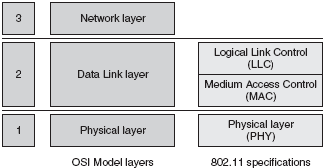The development of wireless LAN standards by the IEEE began in the late 1980s, following the opening up of the three ISM radio bands for unlicensed use by the FCC in 1985, and reached a major milestone in 1997 with the approval and publication of the 802.11 standard.
This standard, which initially specified modest data rates of 1 and 2 Mbps, has been enhanced over the years, the many revisions being denoted by the addition of a suffix letter to the original 802.11, as for example in 802.11a, b and g. The 802.11a and 802.11b extensions were ratified in July 1999, and 802.11b, offering data rates up to 11 Mbps, became the first standard with products to market under the Wi-Fi banner.
The 802.11g specification was ratified in June 2003 and raised the PHY layer data rate to 54 Mbps, while offering a degree of interoperability with 802.11b equipment with which it shares the 2.4 GHz ISM band.
Lits below summarises the 802.11 standard’s relentless march through the alphabet, with various revisions addressing issues such as security, local regulatory compliance and mesh networking, as well as other enhancements that will lift the PHY layer data rate to 600 Mbps.
- 802.11a - High speed WLAN standard, supporting 54 Mbps data rate using OFDM modulation in the 5 GHz ISM band.
- 802.11b - The original Wi-Fi standard, providing 11 Mbps using DSSS and CCK on the 2.4 GHz ISM band.
- 802.11d - Enables MAC level configuration of allowed frequencies, power levels and signal bandwidth to comply with local RF regulations, thereby facilitating international roaming.
- 802.11e - Addresses quality of service (QoS) requirements for all 802.11 radio interfaces, providing TDMA to prioritise and error-correction to enhance performance of delay sensitive applications.
- 802.11f - Defines recommended practices and an Inter-Access Point Protocol to enable access points to exchange the information required to support distribution system services. Ensures inter-operability of access points from multiple vendors, for example to support roaming.
- 802.11g - Enhances data rate to 54 Mbps using OFDM modulation on the 2.4 GHz ISM band. Interoperable in the same network with 802.11b equipment.
- 802.11h - Spectrum management in the 5 GHz band, using dynamic frequency selection (DFS) and transmit power control (TPC) to meet European requirements to minimise interference with military radar and satellite communications.
- 802.11i - Addresses the security weaknesses in user authentication and encryption protocols. The standard employs advanced encryption standard (AES) and 802.1x authentication.
- 802.11j - Japanese regulatory extension to 802.11a adding RF channels between 4.9 and 5.0 GHz.
- 802.11k - Specifies network performance optimisation through channel selection, roaming and TPC. Overall network throughput is maximised by efficiently loading all access points in a network, including those with weaker signal strength.
- 802.11n - Provides higher data rates of 150, 350 and up to 600 Mbps using MIMO radio technology, wider RF channels and protocol stack improvements, while maintaining backward compatibility with 802.11 a, b and g.
- 802.11p - Wireless access for the vehicular environment (WAVE), providing communication between vehicles or from a vehicle to a roadside access point using the licensed intelligent transportation systems (ITS) band at 5.9 GHz.
- 802.11r - Enables fast BSS to BSS (Basic Service Set) transitions for mobile devices, to support delay sensitive services such as VoIP on stations roaming between access points.
- 802.11s - Extending 802.11 MAC to support ESS (Extended Service Set) mesh networking. The 802.11s protocol will enable message delivery over self-configuring multi-hop mesh topologies.
- 802.11T - Recommended practices on measurement methods, performance metrics and test procedures to assess the performance of 802.11 equipment and networks. The capital T denotes a recommended practice rather than a technical standard.
- 802.11u - Amendments to both PHY and MAC layers to provide a generic and standardised approach to inter-working with non-802.11 networks, such as Bluetooth, ZigBee and WiMAX.
- 802.11v - Enhancements to increase throughput, reduce interference and improve reliability through network management.
- 802.11w - Increased network security by extending 802.11 protection to management as well as data frames.
The 802.11 standards cover the PHY and MAC layer definition for local area wireless networking.
As shown in Figure 1, the upper part of the Data Link layer (OSI Layer 2) is provided by Logical Link Control (LLC) services specified in the 802.2 standard, which are also used by Ethernet (802.3) networks, and provide the link to the Network layer and higher layer protocols.
802.11 networks are composed of three basic components; stations, access points and a distribution system, as described below.
- Station - Any device that implements the 802.11 MAC and PHY layer protocols.
- Access point - A station that provides an addressable interface between a set of stations, known as a basic service set (BSS), and the distribution system.
- Distribution system - A network component, commonly a wired Ethernet, that connects access points and their associated BSSs to form an extended service set (ESS).
In the 802.11 standard, WLANs are based on a cellular structure where each cell, under the control of an access point, is known as a basic service set (BSS). When a number of stations are working in a BSS it means that they all transmit and receive on the same RF channel, use a common BSSID, use the same set of data rates and are all synchronised to a common timer.
These BSS parameters are included in “beacon frames” that are broadcast at regular intervals either by individual stations or by the access point. The standard defines two modes of operation for a BSS; ad-hoc mode and infrastructure mode.
An ad-hoc network is formed when a group of two or more 802.11 stations communicate directly with each other with no access point or connection to a wired network. This operating mode (also known as peer-to-peer mode) allows wireless connections to be quickly established for data sharing among a group of wireless enabled computers (Figure 2).
Under ad-hoc mode the service set is called an independent basic service set (IBSS), and in an IBSS all stations broadcast beacon packets, and use a randomly generated BSSID. Infrastructure mode exists when stations are communicating with an access point rather than directly with each other.
A home WLAN with an access point and several wired devices connected through an Ethernet hub or switch is a simple example of a BSS in infrastructure mode (Figure 3).
All communication between stations in a BSS goes through the access point, even if two wireless stations in the same cell need to communicate with each other.
This doubling-up of communication within a cell (first from sending station to the access point, then from the access point to the destination station) might seem like an unnecessary overhead for a simple network, but among the benefits of using a BSS rather than an IBSS is that the access point can buffer data if the receiving station is in standby mode, temporarily out of range or switched off.
In infrastructure mode, the access point takes on the role of broadcasting beacon frames. The access point will also be connected to a distribution system which will usually be a wired network, but could also be a wireless bridge to other WLAN cells.
In this case the cell supported by each access point is a BSS and if two or more such cells exist on a LAN the combined set is known as an extended service set (ESS). In an ESS, access points (APs) will use the distribution system to transfer data from one BSS to another, and also to enable stations to move from one AP to another without any interruption in service.
The transport and routing protocols that operate on the external network have no concept of mobility — of the route to a device changing rapidly — and within the 802.11 architecture the ESS provides this mobility to stations while keeping it invisible to the outside network.
Prior to 802.11k, support for mobility within 802.11 networks was limited to movement of a station between BSSs within a single ESS, so-called BSS transitions. With 802.11k the roaming of stations between ESSs is supported. When a station is sensed as moving out of range, an access point is able to deliver a site report that identifies alternative access points the station can connect to for uninterrupted service.


